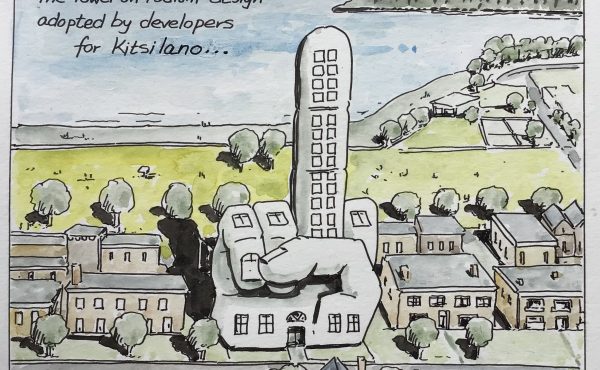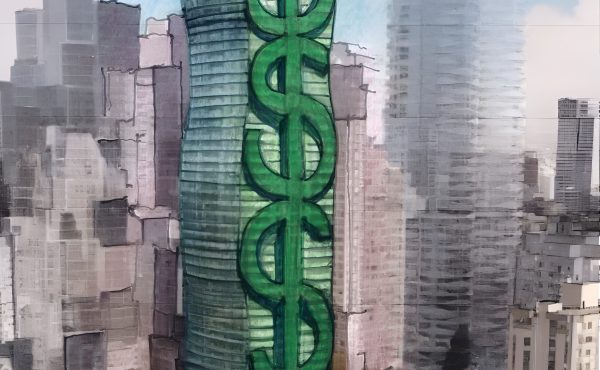Author: BIG Bjarke Ingels Group – Evergreen (2009)
Part architectural monograph, part manga comic book, Yes is More – An Archicomic on Architectural Evolution is a tour de force exposition of BIG, a new (and busy) Copenhagen firm which can already boast an astonishing body of work over its youthful six years of existence. With the book’s visual narrative borrowed from his former employer, Rem Koolhaas, and his seminal S, M, L, XL, BIG’s 36 year-old founder Bjarke Ingels (who already has his own wiki-entry) has distilled not just the design philosophies of modernism and post-modernism here – he also purports a new design philosophy of his own, one which he calls pragmatic utopianism. With his rhetoric that ‘yes is more’ echoing Mies’ ‘less is more,’ the book features 400 pages of cleverly illustrated vignettes, showing in detail the design parties of dozens of their projects, while an interview with Bjarke himself and a feature on the book’s exhibition in Copenhagen closes the manifesto out.
The book’s ambition is clearly an echo of BIG itself, that has recently seen a number of their projects completed. Last month’s Architectural Record featured the firm’s eye-popping ‘8 House’ in Copenhagen, a multi-unit, mid-rise residential building laid out in the shape of a figure eight, complete with a Mobius strip-like green roof. Many extra large (XL) projects in their portfolio include a tower in Shanghai, along with a master plan for Baku, Azerbaijan, while yet other cultural institutions include a museum in Mexico City. Much of the bulk of the book is made up of many unrealized projects, the product of the number of talented young designers working at BIG, all of who are humorously depicted and credited in the opening pages of the book.
The influence of rapid prototyping is also very much evident in BIG’s work – particularly in the extra large schemes of the firm’s portfolio, an approach that also remains in vogue at many architecture schools right now. Projects with complex geometries such as ‘Mountain House’ and ‘House 8’ are the product of new and sophisticated computer software which – along with Computerized Numerical Control (CNC) machines – are allowing young designers like BIG to investigate these geometries in 3D like never before. Design studios once filled with sketch models constructed from foam core board have now been replaced by sculpted foam and resin – yielding structures of poetic eccentricities never before imagined.
Indeed much of the unrealized projects making up Yes is More are creatures existing somewhere between architecture and urban design. Hailing from Copenhagen’s design community – including the likes of Jan Gehl and the late Jorn Utzon – BIG has attracted a small army of workers to realize these visions with Bjarke Ingels. The book is an integral and logical extension of this. One of their more tongue-and-cheek visions in the book is a small vertical city constructed completely from Lego blocks (one of the book’s sponsors), with exquisite detailing right down to the planter boxes in each unit’s balconies.
The book starts off with what is arguably the firm’s most strongest work to date, including their fantastic ‘People’s Building’ and Danish Expo pavilion (both in Shanghai), their experimental ‘VM’ and ‘Mountain’ housing projects in Copenhagen, as well as their aforementioned ‘8 House’. The remainder of the book is visionary on a grand scale, in the spirit of Etienne Boullee’s great monumental structures, with the main difference being that Bjarke is concerned with affordable housing solutions. With instant cities popping up in India and China ripe for his designs, one can only hope that the eco-city models BIG proposes can retain their sustainability when the more fantastic ideas get stripped away.
BIG would also be wise to hope they don’t get what they wish for too quickly since the size of many of their schemes under construction and recently completed are colossal undertakings and therefore need to weather a few years, both financially and technically. As such, their clients must know that they are getting experimental visions in the place of tested and true, business-as-usual architecture. Whether they are capable of both the design development and construction administration is, I suppose, neither here nor there when it comes to great vision. Perhaps to prove the point, they have opened an office in New York to administer the many residential schemes in North America about to get underway.
That some have dismissed BIG and its founder as irreverent is to miss the point entirely. This is an non-authoritative architecture which makes no pretense to any style or philosophy, though Bjarke may just as well be saying ‘Excess is More,’ rather than ‘Yes is More,’ with some influence to be sure of his mentor’s concept of ‘junkspace.’ If his definition of architectural evolution is correct, then the sheer volume of designs this office has produced here will ensure their survival, whether they are taken seriously or not by the larger general public.
His is a generation that has been most recently summed up by an Adbusters writer: “The post-Pop, post-post-Modernists of today have had to deal with the obvious poverty of all imagery and the shoddiness of all aesthetic devices available to them, as well as the blunting of all irony… at best, they have made their own cynicism the subject of their art.” In a way, Yes is More seems to point to the fact that the hipsters have morphed into yupsters, saying yes to everything that the older generations of architects suppressed. Giving credit to Friedrich Nietzsche in the book’s liner notes, Bjarke Ingels sees himself as our new ‘yes man,’ an architectural Zarathustra giving us a new vision to satisfy our post-blog malaise.
***
For more information on BIG, go to their website here.
For more information on the book, go here.





